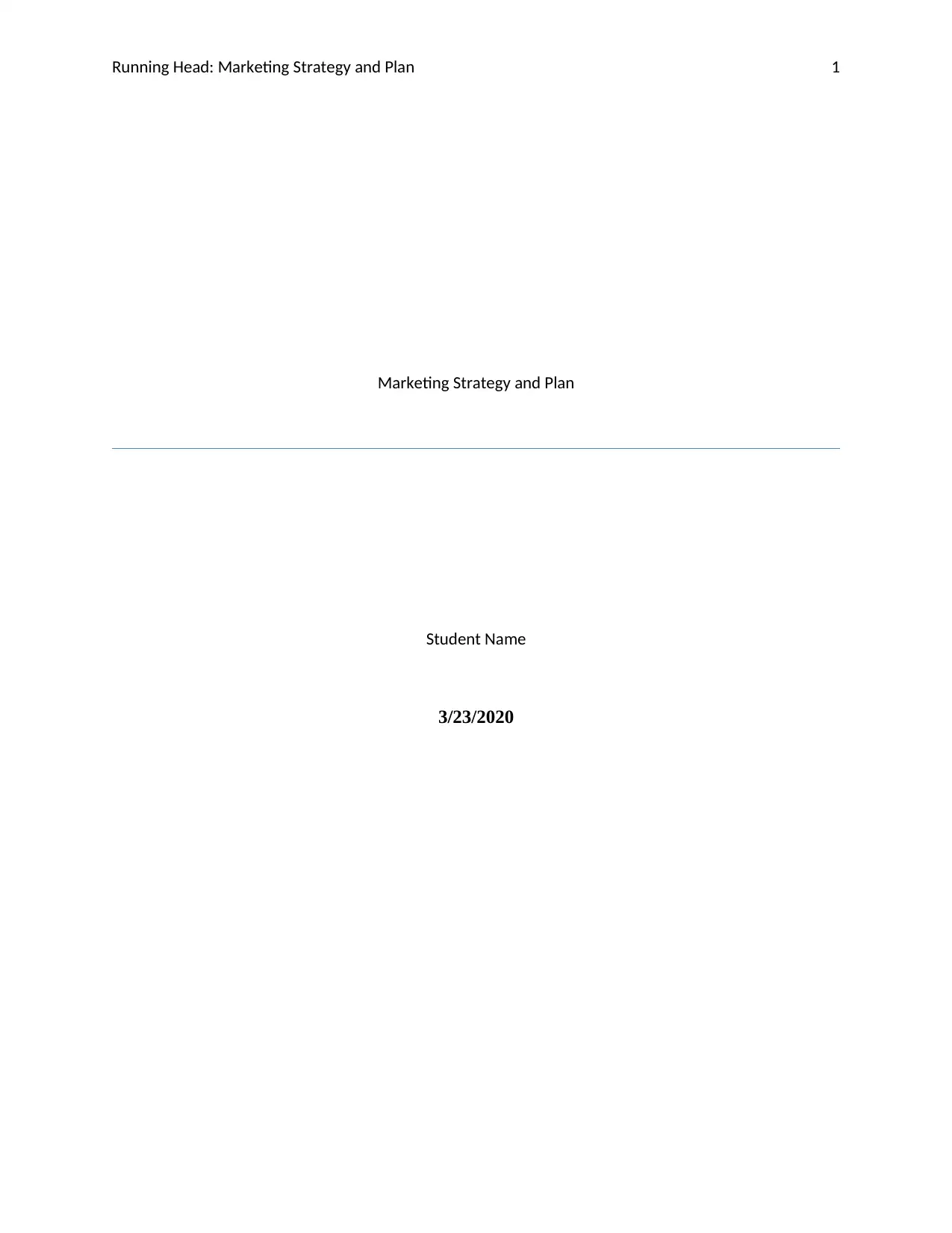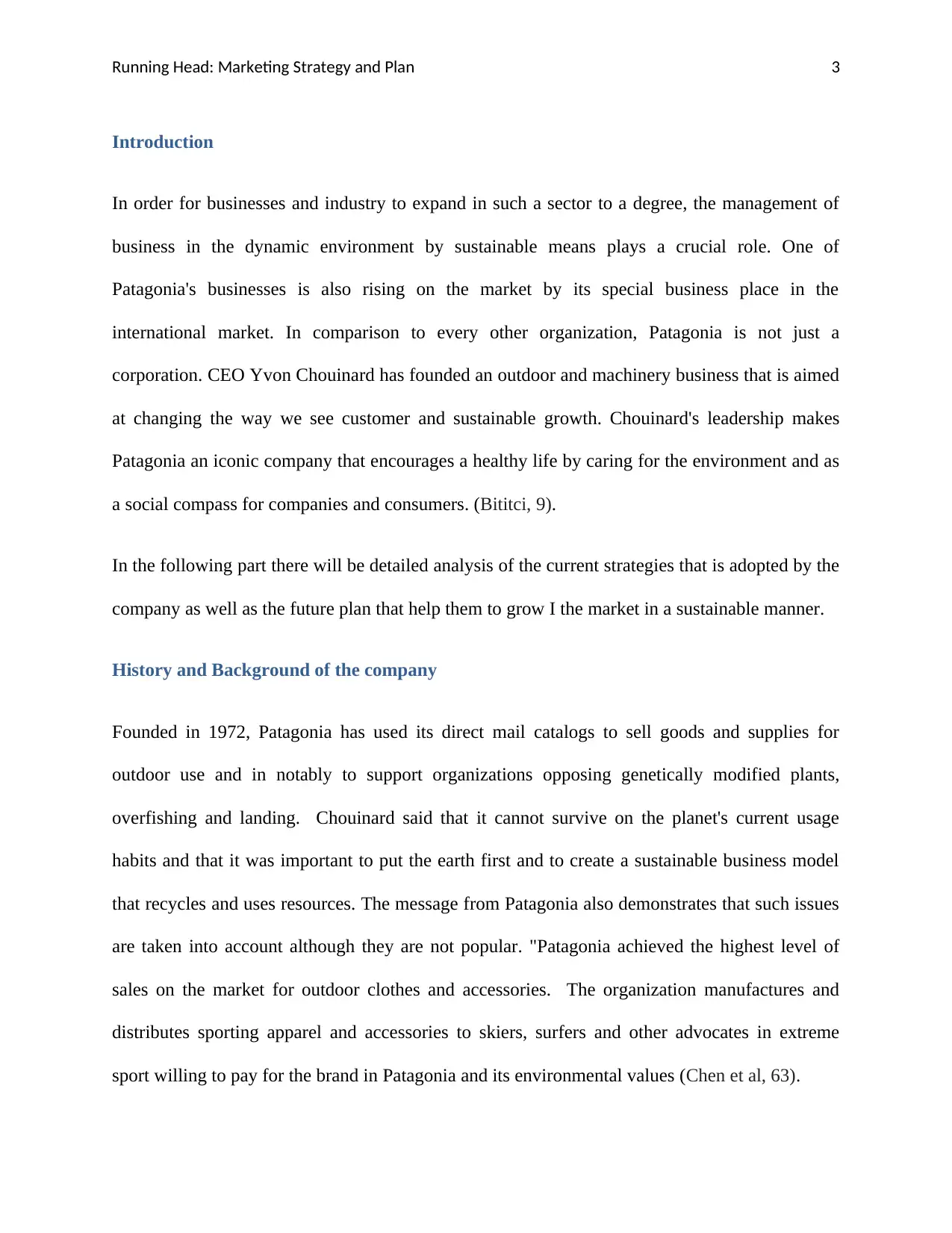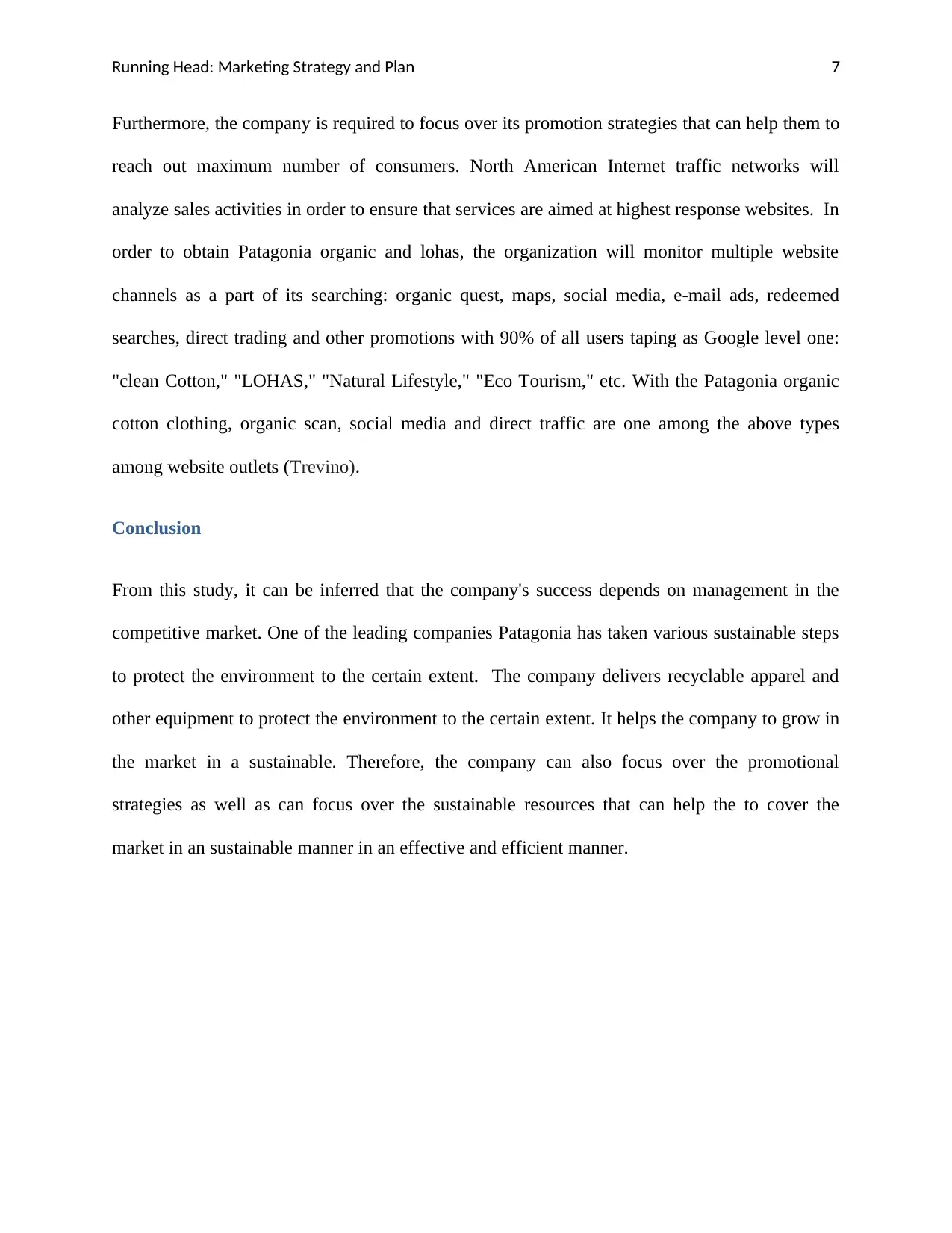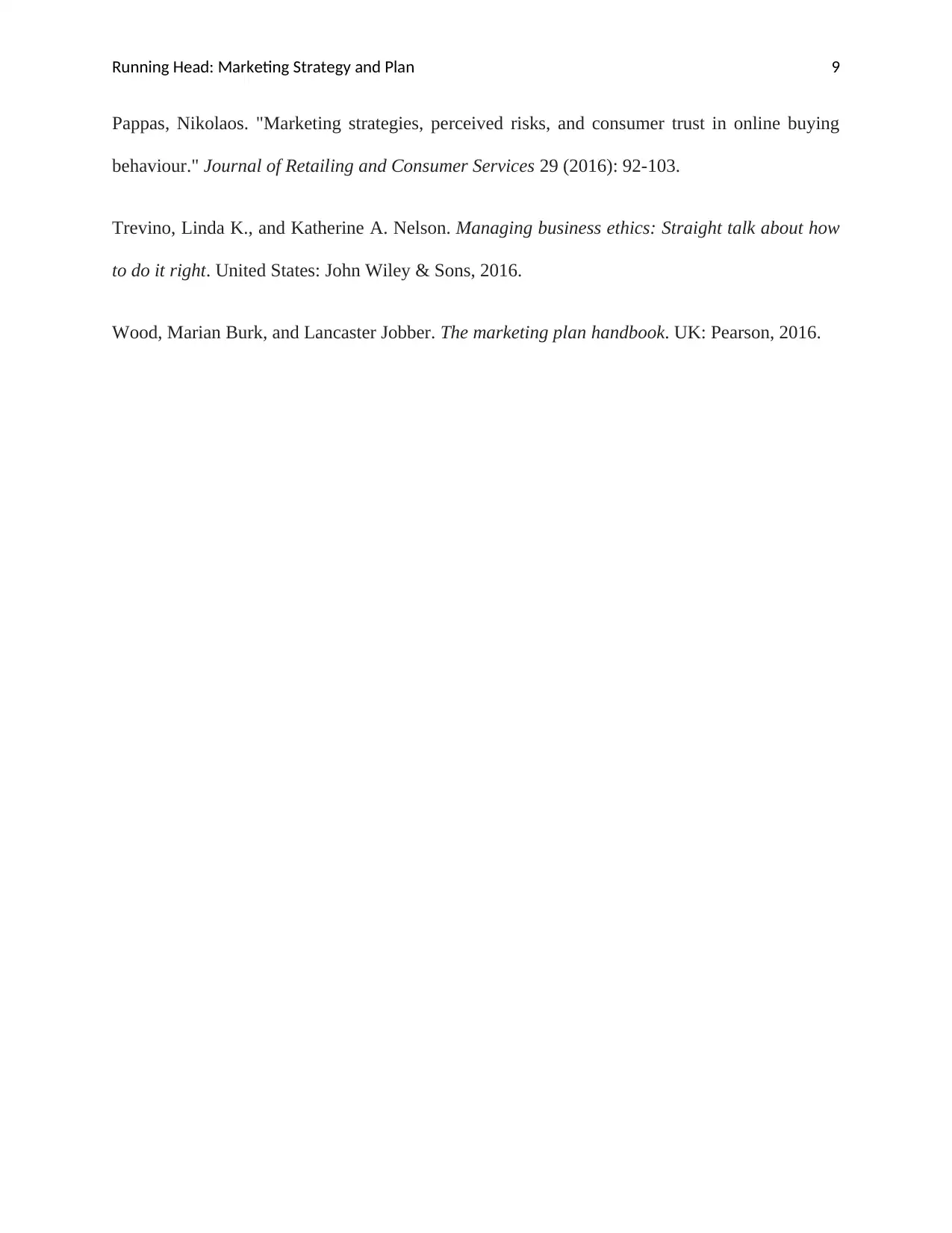Strategic Analysis and Marketing Plan: Patagonia Inc. - Report
VerifiedAdded on 2022/08/27
|9
|1916
|12
Report
AI Summary
This report provides a thorough strategic review of Patagonia Inc., examining its history, background, current brand, and key business-level strategies. It includes a detailed 2020 environmental assessment, highlighting the company's commitment to corporate social responsibility and its innovative approaches to sustainability. The report proposes two high-level strategies for future growth, emphasizing regenerative agriculture and targeted promotional strategies, each linked to key performance indicators such as consumer feedback and online traffic analysis. The analysis underscores Patagonia's dedication to environmental protection and its innovative stakeholder programs, concluding with a focus on sustainable resources and effective market coverage.

Running Head: Marketing Strategy and Plan 1
Marketing Strategy and Plan
Student Name
3/23/2020
Marketing Strategy and Plan
Student Name
3/23/2020
Paraphrase This Document
Need a fresh take? Get an instant paraphrase of this document with our AI Paraphraser

Running Head: Marketing Strategy and Plan 2
Contents
Introduction......................................................................................................................................3
History and Background of the company........................................................................................3
Current brand and key business level strategies..............................................................................3
2020 environmental assessment......................................................................................................4
Strategies for future growth.............................................................................................................5
Conclusion.......................................................................................................................................6
References........................................................................................................................................7
Contents
Introduction......................................................................................................................................3
History and Background of the company........................................................................................3
Current brand and key business level strategies..............................................................................3
2020 environmental assessment......................................................................................................4
Strategies for future growth.............................................................................................................5
Conclusion.......................................................................................................................................6
References........................................................................................................................................7

Running Head: Marketing Strategy and Plan 3
Introduction
In order for businesses and industry to expand in such a sector to a degree, the management of
business in the dynamic environment by sustainable means plays a crucial role. One of
Patagonia's businesses is also rising on the market by its special business place in the
international market. In comparison to every other organization, Patagonia is not just a
corporation. CEO Yvon Chouinard has founded an outdoor and machinery business that is aimed
at changing the way we see customer and sustainable growth. Chouinard's leadership makes
Patagonia an iconic company that encourages a healthy life by caring for the environment and as
a social compass for companies and consumers. (Bititci, 9).
In the following part there will be detailed analysis of the current strategies that is adopted by the
company as well as the future plan that help them to grow I the market in a sustainable manner.
History and Background of the company
Founded in 1972, Patagonia has used its direct mail catalogs to sell goods and supplies for
outdoor use and in notably to support organizations opposing genetically modified plants,
overfishing and landing. Chouinard said that it cannot survive on the planet's current usage
habits and that it was important to put the earth first and to create a sustainable business model
that recycles and uses resources. The message from Patagonia also demonstrates that such issues
are taken into account although they are not popular. "Patagonia achieved the highest level of
sales on the market for outdoor clothes and accessories. The organization manufactures and
distributes sporting apparel and accessories to skiers, surfers and other advocates in extreme
sport willing to pay for the brand in Patagonia and its environmental values (Chen et al, 63).
Introduction
In order for businesses and industry to expand in such a sector to a degree, the management of
business in the dynamic environment by sustainable means plays a crucial role. One of
Patagonia's businesses is also rising on the market by its special business place in the
international market. In comparison to every other organization, Patagonia is not just a
corporation. CEO Yvon Chouinard has founded an outdoor and machinery business that is aimed
at changing the way we see customer and sustainable growth. Chouinard's leadership makes
Patagonia an iconic company that encourages a healthy life by caring for the environment and as
a social compass for companies and consumers. (Bititci, 9).
In the following part there will be detailed analysis of the current strategies that is adopted by the
company as well as the future plan that help them to grow I the market in a sustainable manner.
History and Background of the company
Founded in 1972, Patagonia has used its direct mail catalogs to sell goods and supplies for
outdoor use and in notably to support organizations opposing genetically modified plants,
overfishing and landing. Chouinard said that it cannot survive on the planet's current usage
habits and that it was important to put the earth first and to create a sustainable business model
that recycles and uses resources. The message from Patagonia also demonstrates that such issues
are taken into account although they are not popular. "Patagonia achieved the highest level of
sales on the market for outdoor clothes and accessories. The organization manufactures and
distributes sporting apparel and accessories to skiers, surfers and other advocates in extreme
sport willing to pay for the brand in Patagonia and its environmental values (Chen et al, 63).
⊘ This is a preview!⊘
Do you want full access?
Subscribe today to unlock all pages.

Trusted by 1+ million students worldwide

Running Head: Marketing Strategy and Plan 4
Current brand and key business level strategies
Once it comes to executing a plan at the business level, it is clear that Patagonia works with a
policy of distinction in mind. Patagonia can build and maintain a strategic edge by delivering
exclusive, premium goods to its consumers. Using their positive brand identity and creative
product styles, Patagonia draws consumers to its market and holds them waiting for more. For
Patagonia, the cost of a clothing or outdoor object isn't as critical as good quality. It is clearly
seems by gazing at the costs of goods from Patagonia and the ingredients used to produce such
goods (Gorondutse, 1141).
Patagonia is now leveraging state-of - the-art technologies to grow its goods and further support
a market-place competitiveness plan. Most of their jackets and trousers feature wind and water-
resistant technology to offer the best outdoor experience possible for customers. Technical
structures of Patagonia are often dialed into environmental conditions, giving Patagonia a quality
which makes it difficult for competitors to mimic (Haider, 22).
Patagonia employs an environmental distinction approach focused on a mission of protection and
preservation of the environment and a value basis that encompasses sustainability, dignity,
ecology, not constrained by tradition, and Zen philosophy. "Make the right product, do no harm
without need, take business to inspire, bring approaches to the environmental crisis," the
Patagonia mission statement says. The business model implementing the strategy relies on
innovation in its methods, products and services and organizational theory. Innovation helps the
business through corporate performance, consumer awareness, product growth and
environmental protection to achieve productivity. Customers are involved in an outstanding
Current brand and key business level strategies
Once it comes to executing a plan at the business level, it is clear that Patagonia works with a
policy of distinction in mind. Patagonia can build and maintain a strategic edge by delivering
exclusive, premium goods to its consumers. Using their positive brand identity and creative
product styles, Patagonia draws consumers to its market and holds them waiting for more. For
Patagonia, the cost of a clothing or outdoor object isn't as critical as good quality. It is clearly
seems by gazing at the costs of goods from Patagonia and the ingredients used to produce such
goods (Gorondutse, 1141).
Patagonia is now leveraging state-of - the-art technologies to grow its goods and further support
a market-place competitiveness plan. Most of their jackets and trousers feature wind and water-
resistant technology to offer the best outdoor experience possible for customers. Technical
structures of Patagonia are often dialed into environmental conditions, giving Patagonia a quality
which makes it difficult for competitors to mimic (Haider, 22).
Patagonia employs an environmental distinction approach focused on a mission of protection and
preservation of the environment and a value basis that encompasses sustainability, dignity,
ecology, not constrained by tradition, and Zen philosophy. "Make the right product, do no harm
without need, take business to inspire, bring approaches to the environmental crisis," the
Patagonia mission statement says. The business model implementing the strategy relies on
innovation in its methods, products and services and organizational theory. Innovation helps the
business through corporate performance, consumer awareness, product growth and
environmental protection to achieve productivity. Customers are involved in an outstanding
Paraphrase This Document
Need a fresh take? Get an instant paraphrase of this document with our AI Paraphraser

Running Head: Marketing Strategy and Plan 5
quality offering and in the good experience of doing business with Patagonia. Income, growth
and market share have the potential to maximize Patagonia's interest (Ismail).
2020 environmental assessment
Patagonia is commonly recognized as a pioneer of corporate social responsibility, which it aims
to do both directly through contributions of its income and internal recycling programs and
indirectly through consciousness raising of environmental matters. Two of the brand's efforts
include reporting and releasing information about the supply chain; contributing one percent of
the proceeds to conservation organizations; and developing a website named Used Wear to resell
recycled Patagonia apparel as a way to minimize waste. They have created modern, more durable
fabrics, such as rubber based on desert shrub, to replace conventional petroleum based wetsuit
fabrics. They have already collaborated on a forum entitled "The Cleanest Side" and a video on
the negative ecological effects of dams entitled "River Country" to raise support about many
issues. Today, the company's website carries the slogan "Government needs turning up" to
encourage voter participation, and this is not the first time the brand has used innovative
promotional strategies (Kenney, 44).
The corporation funds community-based groups are frequently edgy and off the beaten track–
operating in their own backyards to generate meaningful impact for the world. Such individual
fights are the most successful way for the public to raise more complex issues, particularly
biodiversity, habitat conservation and climate change (McDONALD, 108).
Patagonia offers goods to customers that represent the highest expectations of sustainable
procurement and communicate principles with stakeholders openly. In fact, Patagonia specializes
in innovative and action-oriented stakeholder programs through its Sustainable Funding Program
quality offering and in the good experience of doing business with Patagonia. Income, growth
and market share have the potential to maximize Patagonia's interest (Ismail).
2020 environmental assessment
Patagonia is commonly recognized as a pioneer of corporate social responsibility, which it aims
to do both directly through contributions of its income and internal recycling programs and
indirectly through consciousness raising of environmental matters. Two of the brand's efforts
include reporting and releasing information about the supply chain; contributing one percent of
the proceeds to conservation organizations; and developing a website named Used Wear to resell
recycled Patagonia apparel as a way to minimize waste. They have created modern, more durable
fabrics, such as rubber based on desert shrub, to replace conventional petroleum based wetsuit
fabrics. They have already collaborated on a forum entitled "The Cleanest Side" and a video on
the negative ecological effects of dams entitled "River Country" to raise support about many
issues. Today, the company's website carries the slogan "Government needs turning up" to
encourage voter participation, and this is not the first time the brand has used innovative
promotional strategies (Kenney, 44).
The corporation funds community-based groups are frequently edgy and off the beaten track–
operating in their own backyards to generate meaningful impact for the world. Such individual
fights are the most successful way for the public to raise more complex issues, particularly
biodiversity, habitat conservation and climate change (McDONALD, 108).
Patagonia offers goods to customers that represent the highest expectations of sustainable
procurement and communicate principles with stakeholders openly. In fact, Patagonia specializes
in innovative and action-oriented stakeholder programs through its Sustainable Funding Program

Running Head: Marketing Strategy and Plan 6
and campaigns that increase awareness and tackle urgent environmental concerns (Mullins et al,
161).
The dedication of Patagonia to provide the most environmentally friendly products possible (or
to manufacture them, when necessary) reaches into the commodity and into the supply chain
itself. As of 2019, all vendors were required to conduct an annual social or environmental audit,
with preparation given at the lowest rate for those participating. Select manufacturers also
provide a pre-screen on social and environmental results and the Social and Environmental
Responsibility Committee of Patagonia has the right to veto making an order depending on
certain criteria at a facility (Nickols, 4).
Strategies for future growth
Patagonia told its staff in December that the brand's mission statement changed to a simpler,
more urgent message: "Patagonia is in business to save our home world. “Chouinard wants
Patagonia to take meaningful measures against the main sources of climate change, instead of
funding various symptom-focused organizations. Therefore, the company can focusing on its
capital is one of the better ways to have adequate effects. Regenerative agriculture, for example,
an approach to agricultural processes aimed at regenerating topsoil and increasing habitat by
collecting as much crop waste as possible, has become a must. Recent experiments have found
that, if conducted properly, this method of agriculture will absorb more carbon than it emits and
help reverse the act of global warming. The efficiency of such strategy will be analyzed through
the KPI tool which is consumer feedback platform. Through such platform, the company can
able to get know about the view of the consumers towards the efficiency of strategies according
to which the changes will be done (Pappas, 92).
and campaigns that increase awareness and tackle urgent environmental concerns (Mullins et al,
161).
The dedication of Patagonia to provide the most environmentally friendly products possible (or
to manufacture them, when necessary) reaches into the commodity and into the supply chain
itself. As of 2019, all vendors were required to conduct an annual social or environmental audit,
with preparation given at the lowest rate for those participating. Select manufacturers also
provide a pre-screen on social and environmental results and the Social and Environmental
Responsibility Committee of Patagonia has the right to veto making an order depending on
certain criteria at a facility (Nickols, 4).
Strategies for future growth
Patagonia told its staff in December that the brand's mission statement changed to a simpler,
more urgent message: "Patagonia is in business to save our home world. “Chouinard wants
Patagonia to take meaningful measures against the main sources of climate change, instead of
funding various symptom-focused organizations. Therefore, the company can focusing on its
capital is one of the better ways to have adequate effects. Regenerative agriculture, for example,
an approach to agricultural processes aimed at regenerating topsoil and increasing habitat by
collecting as much crop waste as possible, has become a must. Recent experiments have found
that, if conducted properly, this method of agriculture will absorb more carbon than it emits and
help reverse the act of global warming. The efficiency of such strategy will be analyzed through
the KPI tool which is consumer feedback platform. Through such platform, the company can
able to get know about the view of the consumers towards the efficiency of strategies according
to which the changes will be done (Pappas, 92).
⊘ This is a preview!⊘
Do you want full access?
Subscribe today to unlock all pages.

Trusted by 1+ million students worldwide

Running Head: Marketing Strategy and Plan 7
Furthermore, the company is required to focus over its promotion strategies that can help them to
reach out maximum number of consumers. North American Internet traffic networks will
analyze sales activities in order to ensure that services are aimed at highest response websites. In
order to obtain Patagonia organic and lohas, the organization will monitor multiple website
channels as a part of its searching: organic quest, maps, social media, e-mail ads, redeemed
searches, direct trading and other promotions with 90% of all users taping as Google level one:
"clean Cotton," "LOHAS," "Natural Lifestyle," "Eco Tourism," etc. With the Patagonia organic
cotton clothing, organic scan, social media and direct traffic are one among the above types
among website outlets (Trevino).
Conclusion
From this study, it can be inferred that the company's success depends on management in the
competitive market. One of the leading companies Patagonia has taken various sustainable steps
to protect the environment to the certain extent. The company delivers recyclable apparel and
other equipment to protect the environment to the certain extent. It helps the company to grow in
the market in a sustainable. Therefore, the company can also focus over the promotional
strategies as well as can focus over the sustainable resources that can help the to cover the
market in an sustainable manner in an effective and efficient manner.
Furthermore, the company is required to focus over its promotion strategies that can help them to
reach out maximum number of consumers. North American Internet traffic networks will
analyze sales activities in order to ensure that services are aimed at highest response websites. In
order to obtain Patagonia organic and lohas, the organization will monitor multiple website
channels as a part of its searching: organic quest, maps, social media, e-mail ads, redeemed
searches, direct trading and other promotions with 90% of all users taping as Google level one:
"clean Cotton," "LOHAS," "Natural Lifestyle," "Eco Tourism," etc. With the Patagonia organic
cotton clothing, organic scan, social media and direct traffic are one among the above types
among website outlets (Trevino).
Conclusion
From this study, it can be inferred that the company's success depends on management in the
competitive market. One of the leading companies Patagonia has taken various sustainable steps
to protect the environment to the certain extent. The company delivers recyclable apparel and
other equipment to protect the environment to the certain extent. It helps the company to grow in
the market in a sustainable. Therefore, the company can also focus over the promotional
strategies as well as can focus over the sustainable resources that can help the to cover the
market in an sustainable manner in an effective and efficient manner.
Paraphrase This Document
Need a fresh take? Get an instant paraphrase of this document with our AI Paraphraser

Running Head: Marketing Strategy and Plan 8
References
Bititci, Umit S. Managing business performance: The science and the art. United States: John
Wiley & Sons, 2016.
Chen, Yu, John Daniel Eshleman, and Jared S. Soileau. "Business strategy and auditor
reporting." Auditing: A Journal of Practice & Theory 36.2 (2017): 63-86.
Gorondutse, Abdullahi Hassan, and Haim Hilman. "Testing the Effect of Business-level Strategy
on Performance of Hotels." Global Business Review 20.5 (2019): 1141-1154.
Haider, Ahmad Ali, et al. "Marketing Management." Head, B (2017): 22.
Ismail, Mariam H., Mohamed Khater, and Mohamed Zaki. "Digital business transformation and
strategy: What do we know so far." Cambridge Service Alliance, November (2017).
Kenney, Andrew. "Patagonia: A case study in managing a mission." Journal of
Accountancy 226.1 (2018): 44-45.
McDONALD, M. A. L. C. O. L. M. "Strategic marketing planning: theory and practice." The
marketing book. Routledge, 2016. 108-142.
Mullins, Ryan, et al. "Managing Control Expectations in Business-To-Business
Relationships." Looking Forward, Looking Back: Drawing on the Past to Shape the Future of
Marketing. Springer, Cham, 2016. 161-163.
Nickols, Fred. "Strategy, strategic management, strategic planning and strategic
thinking." Management Journal 1.1 (2016): 4-7.
References
Bititci, Umit S. Managing business performance: The science and the art. United States: John
Wiley & Sons, 2016.
Chen, Yu, John Daniel Eshleman, and Jared S. Soileau. "Business strategy and auditor
reporting." Auditing: A Journal of Practice & Theory 36.2 (2017): 63-86.
Gorondutse, Abdullahi Hassan, and Haim Hilman. "Testing the Effect of Business-level Strategy
on Performance of Hotels." Global Business Review 20.5 (2019): 1141-1154.
Haider, Ahmad Ali, et al. "Marketing Management." Head, B (2017): 22.
Ismail, Mariam H., Mohamed Khater, and Mohamed Zaki. "Digital business transformation and
strategy: What do we know so far." Cambridge Service Alliance, November (2017).
Kenney, Andrew. "Patagonia: A case study in managing a mission." Journal of
Accountancy 226.1 (2018): 44-45.
McDONALD, M. A. L. C. O. L. M. "Strategic marketing planning: theory and practice." The
marketing book. Routledge, 2016. 108-142.
Mullins, Ryan, et al. "Managing Control Expectations in Business-To-Business
Relationships." Looking Forward, Looking Back: Drawing on the Past to Shape the Future of
Marketing. Springer, Cham, 2016. 161-163.
Nickols, Fred. "Strategy, strategic management, strategic planning and strategic
thinking." Management Journal 1.1 (2016): 4-7.

Running Head: Marketing Strategy and Plan 9
Pappas, Nikolaos. "Marketing strategies, perceived risks, and consumer trust in online buying
behaviour." Journal of Retailing and Consumer Services 29 (2016): 92-103.
Trevino, Linda K., and Katherine A. Nelson. Managing business ethics: Straight talk about how
to do it right. United States: John Wiley & Sons, 2016.
Wood, Marian Burk, and Lancaster Jobber. The marketing plan handbook. UK: Pearson, 2016.
Pappas, Nikolaos. "Marketing strategies, perceived risks, and consumer trust in online buying
behaviour." Journal of Retailing and Consumer Services 29 (2016): 92-103.
Trevino, Linda K., and Katherine A. Nelson. Managing business ethics: Straight talk about how
to do it right. United States: John Wiley & Sons, 2016.
Wood, Marian Burk, and Lancaster Jobber. The marketing plan handbook. UK: Pearson, 2016.
⊘ This is a preview!⊘
Do you want full access?
Subscribe today to unlock all pages.

Trusted by 1+ million students worldwide
1 out of 9
Related Documents
Your All-in-One AI-Powered Toolkit for Academic Success.
+13062052269
info@desklib.com
Available 24*7 on WhatsApp / Email
![[object Object]](/_next/static/media/star-bottom.7253800d.svg)
Unlock your academic potential
Copyright © 2020–2025 A2Z Services. All Rights Reserved. Developed and managed by ZUCOL.





